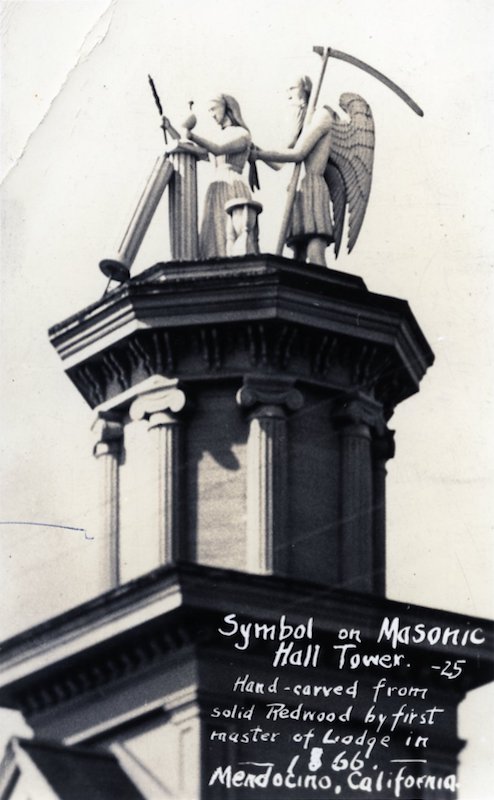
The best-known local dad, Father Time and the Maiden. Photograph of statuary on top of the Masonic Temple in Mendocino. Writing on the front says, “Symbol on Masonic Hall Tower. Hand carved from solid Redwood by first master of Lodge in 1866. Mendocino, California.” The statuary consists of Father Time, the Hourglass of Transience, the Maiden, the Anointment of her Hair, the Acacia Branch in one hand, the Sacred Urn in the other, the Broken Column, and the Book of Light, all drawn from masonic lore. It is symbolic of a particular rite of passage within the Masonic Order from one degree to another.
Last month we explored the origins of Mother’s Day in the peace and reconciliation movement following the Civil War. This month, we will locate the source of Father’s Day in, big surprise, Mother’s Day. The first commercial Mother’s Day was observed by a department store in Philadelphia in 1908. Thanks to its promotion by retailers, it caught on right away. In 1909, 45 states observed Mother’s Day, and in 1914 Woodrow Wilson made the second Sunday in May a holiday in honor of “that tender, gentle army, the mothers of America.”
The campaign to celebrate the nation’s fathers did not generate the same level of enthusiasm, perhaps because, as one florist explained, “Fathers haven’t the same sentimental appeal that mothers have.” On July 5, 1908, a West Virginia church sponsored the nation’s first event explicitly in honor of fathers, a Sunday service in memory of the 362 men who had died in the previous December’s explosions at the Fairmont Coal Company mines in Monongah, but it was a one-time commemoration and not an annual event.
The next year, a Spokane woman named Sonora Smart Dodd listened to a Mother’s Day sermon at Central Methodist Episcopal Church. Dodd’s own mother had died in childbirth 11 years earlier, and her father had raised their six children alone. Dodd felt moved to honor her father, and fathers everywhere, with a special day. She went to local churches, the YMCA, shopkeepers, and government officials to drum up support for her idea. She was successful and Washington State designated the nation’s first statewide Father’s Day on June 19, 1910. William Jennings Bryan, one of the foremost politicians of the time and himself the father of three, sent Dodd a congratulatory letter that sparked a rush of national media attention on her and her cause.
In 1916, Woodrow Wilson pushed to make Father’s Day official, but couldn’t muster enough support from Congress. In 1924, Calvin Coolidge urged state governments to observe Father’s Day, but many men continued to disdain the day. According to one historian, “They scoffed at sentimental attempts to domesticate manliness with flowers and hankies, or they derided such holidays as commercial gimmicks to sell products often paid for by the father himself.”
During the 1920s and 1930s, a movement arose to scrap Mother’s Day and Father’s Day altogether in favor of a single holiday, Parents’ Day. However, the Great Depression derailed this; struggling retailers, trade groups, and advertisers redoubled their efforts to make Father’s Day a “second Christmas” for men, promoting goods such as neckties, hats, socks, handkerchiefs, pipes and tobacco, and golf clubs. And greeting cards, of course. In 1938, a Father’s Day Council was founded by the New York Associated Men’s Wear Retailers to promote the day.
When World War II began, advertisers argued that Father’s Day was a way to honor American troops and support the war effort. By the end of the war, it may not have been a federal holiday, but it was a national institution. In 1957, Maine Senator Margaret Chase Smith introduced a proposal accusing Congress of ignoring fathers for 40 years while honoring mothers, thus “singling out just one of our two parents.” In 1966, Lyndon Johnson designated the third Sunday in June as Father’s Day. In 1972, in the middle of his presidential re-election campaign (when he wasn’t busy directing the Watergate Plumbers), Richard Nixon signed a proclamation making Father’s Day a federal holiday. We may never know whether that contributed to his landslide defeat of George McGovern, but it left us with a way to honor the other one of our parents.
New Exhibit! “Water Tower Wonderland” Discover the beauty, ingenuity, and architecture of these iconic structures in the Kelley House Museum’s summer exhibit, “Water Tower Wonderland.” Using historic photographs, original pieces from local artists, and small-scale models, the exhibit explores the majesty and functionality of many well-known water towers, several still standing and some that aren’t. On display will be renderings of Mendocino water towers in several media, with serigraphs by Anne Kendall Foote and Bill Zacha, a quilt square by Dee Goodrich, and a linocut by Emmy Lou Packard. The Kelley House has also been working closely with Mendocino High School, and the exhibit includes pastels and architectural models made by students. 45007 Albion Street, Mendocino. Thursday-Monday, 11am – 3pm. Now until September 18.